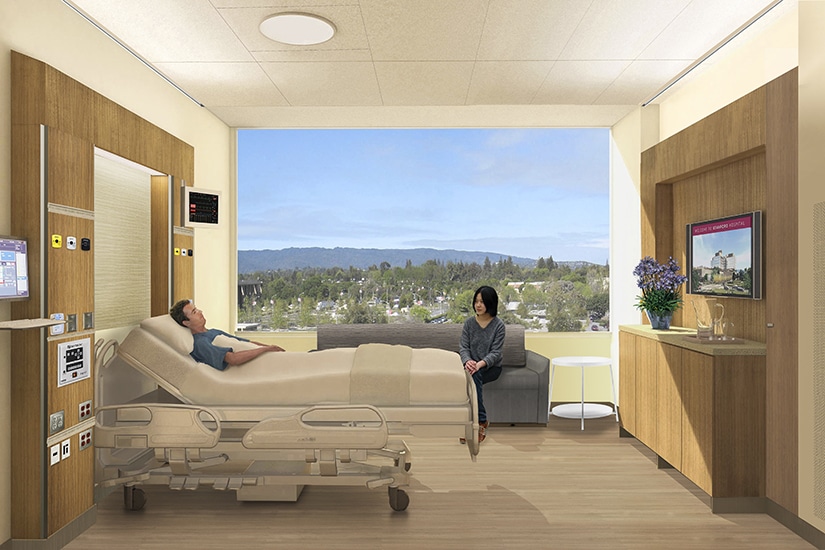|
Getting your Trinity Audio player ready...
|
Advanced technological features are so deeply embedded within Stanford Health Care’s new hospital that they start at a subterranean level. To meet California’s new seismic standards, architects built the facility on 208 base isolators that will allow it to shift up to three feet in any direction during an earthquake, says David Entwistle, Stanford Health Care’s president and CEO.
“The building stays intact and is basically rotating on its base to prevent damage in the event of an earthquake,” says Entwistle, who explains that the hospital was designed to withstand an 8.0 magnitude quake. “I hope we never have to, but it would be quite amazing to see that.”

The facility’s focus on architecture also extends skyward in the form of a three-story atrium crowned by a glass dome that’s 120 feet in diameter. Within the hospital’s walls, patients and their families will also find 368 all-private rooms equipped with tablet computers and TVs meant for more than entertainment. Patients can use their tablets to order food, cue up educational material about their medical condition, and stream content to the 55-inch televisions in their rooms, all of which have sleeping sofas to accommodate overnight guests. They can also video conference with their healthcare providers directly from bed using the in-room tech tools. The building’s grounds also feature more than four acres of gardens designed to create a unique healing environment both inside and out at the 824,000 square-foot hospital.
“Whether you’re talking about the larger private rooms and the amenities there, or the aesthetically pleasing way that we have used art, or even the architecture of the building, it’s an amazing facility,” Entwistle says. “What we have tried to achieve in the hospital we built is to create the care environment that will help healing.”
The new facility also has some sleek features that would be at home in an Apple store; no coincidence given the current Apple store concept was designed by Ron Johnson, a Stanford Health Care board member. Stanford also has partnerships with Silicon Valley companies including Cisco, Intel, and VMware.
“As we worked with Rafael Viñoly Architects, we wanted to make sure we had a look and feel to the space that, in essence, would expose the technology and sophistication that we have here at Stanford,” Entwistle says.

At the same time, some of the building’s innovations are decidedly low-tech. The hospital’s operating rooms also include windows, which haven’t been a standard feature in the past. The facility’s waiting rooms are also larger than those in the original hospital, which was constructed in 1959, and patient rooms all include oversized glass that allows occupants to enjoy natural light or easily darken the room for daytime naps. These are seemingly small changes that can have a significant impact on patient and staff satisfaction, according to Entwistle. He says input from the hospital’s staff and its patient and family partner program participants helped project planners tailor technology and other building perks with patients and providers in mind.
“We feel the experience the patient has when they come in has a lot to do with what their health outcome is,” he says. “Using our caregivers, using our staff, and truly using our patient and family partnership program allows us to evaluate these things and look at what would be the most meaningful for our patients.”

Prioritizing the patient experience has become increasingly important for hospitals now that more people are approaching healthcare from a critical consumer perspective. Entwistle says his previous organization, University of Utah Hospitals and Clinics, was the first in the country to put patients’ physician satisfaction scores online. Today, that transparency is becoming the norm across the industry.
“I think that data—whether you are looking at quality data, cost data, experience data—is becoming much more visible to patients now than it was before, which allows them to make better educated decisions about where they want to go for healthcare.”
State-of-the-art imaging equipment, expanded laboratory space, and other upgrades in the new hospital will be less visible to patients, but contribute to care for years to come, Entwistle says.

To offer a few practical examples, he explained that doctors can now use sophisticated iMRI equipment in operating rooms to search for signs they have completely removed a tumor while a patient is still undergoing a procedure. This often eliminates the need for a second surgery. Stanford Health Care clinicians can also tap genetic data to develop targeted care plans for cancer patients based on what their bodies will respond to best. And the academic medical center’s deep data sets and cutting-edge technology have helped healthcare providers solve some medical cold cases that have stumped other doctors.
“Because of that genetic data and some of the other things we have been able to put together in large data sets, we can now diagnose up to 25 percent of patients coming in here who were previously undiagnosed,” he says.
Entwistle believes academic medical centers, where he’s spent the majority of his more than twenty-year career, set standards for the healthcare industry in more ways than one. Academic hospitals teach and train the physicians of the future, and their labs provide the petri dish for much of the medical research happening today. Finally, academic hospitals allow providers to put ideas into practice.
“So that education, teaching research and the application of that in our clinical care environment really allows us to be innovative and also to bring forward the latest in treatments and technologies—setting the bar for the field,” he says. “I really feel like we are developing the next generation of medicines and also the caregivers who will provide them.”
But, once caregivers have been trained and those new medicines tested, they should be doing more of their work outside the hospital setting, Entwistle says. Like many healthcare companies, Stanford Health Care operates an expansive network of specialized outpatient clinics and medical centers where patients can reap the benefits of the research and innovations of the flagship academic hospital from the comfort of their own beds by the end of the day.
“Hopefully, over time, there will be less and less of a reliance on the hospital for a lot of the things that you can do on an outpatient basis, which makes it better for the patient, even though we have created a great environment.”

